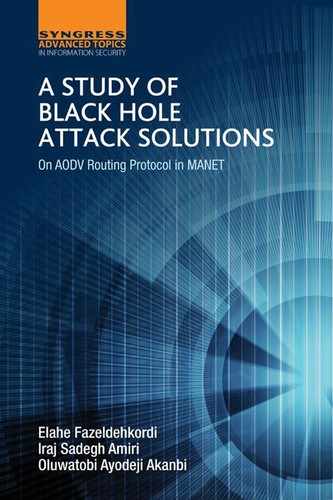Conclusion and Future Work
Abstract
In this study, we analyzed effect of the black hole in an AODV network. For this purpose, we implemented an AODV protocol that behaves as black hole in NS-2.35. We simulated 9 scenarios in this book on 6, 20, and 30 nodes, where the simulation was done with UDP and not TCP packets. In every scenario, we implemented network performance after and before multiple black hole attacks. After that simulated IDSAODV solution with same scenarios to observe AODV behavior versus multiple black hole attacks under this proposed solution. First, investigated effects of black hole attack on network performance which this attack increase number of drop packets and decrease packet delivery ratio, even with adding the number of black hole nodes, drop packets increase more and packet delivery ratio drops off. After implementing IDSAODV on the network, drop packets decreased and packet delivery ratio improved. Other benefits of this solution are that the proposed solution requests minimum modification on AODV. It does not change packet format and can work together with AODV protocol and does not request additional routing overhead.
Keywords
AODV network; UDP; TCP; IDSAODV; AODV protocol
6.1 Overview
In this study, we analyzed effect of the black hole in an AODV network. For this purpose, we implemented an AODV protocol that behaves as black hole in NS-2.35. We simulated 9 scenarios in this book on 6, 20, and 30 nodes, where the simulation was done with UDP and not TCP packets. In every scenario, we implemented network performance after and before multiple black hole attacks. After that, simulated IDSAODV solution with same scenarios to observe AODV behavior versus multiple black hole attacks under this proposed solution. First, investigated effects of black hole attack on network performance, which this attack increase number of drop packets and decrease packet delivery ratio, even with adding the number of black hole nodes, drop packets increase more, and packet delivery ratio drops off. After implementing IDSAODV on the network, drop packets decreased and packet delivery ratio improved. Other benefits of this solution are that the proposed solution requests minimum modification on AODV. It does not change packet format and can work together with AODV protocol and does not request additional routing overhead.
Black hole attack increases number of drop packets and decrease packet delivery ratio on MANET performance. After applying multiple numbers of black hole nodes on the network, drop packets will be more increased and packet delivery ratio drops off. Implementing IDSAODV on the network decreases drop packets and improves packet delivery ratio. IDSAODV solution requests minimum modification on AODV. IDSAODV does not change packet format and can work together with AODV protocol and does not request additional routing overhead.
6.2 Contribution
The contributions of this book are listed as below:
• Effects of single black hole attack and multiple black hole attacks on MANET performance have investigated for networks with 10 different numbers of nodes.
• IDSAODV as a solution for black hole attack on MANET with single black hole attack and multiple black hole attacks for networks with 10 different numbers of nodes have implemented.
• Impacts of IDSAODV on MANET performance with multiple black hole attacks compared with its impacts on single black hole attack.
6.3 Future Work
According to our research, IDSAODV improve PDR and total drop packet but it cannot improve enough end-to-end delay and routing overhead against multiple black hole attacks, so future work will expand our research on other solutions that can more improve these parameters versus multiple black hole attacks.
